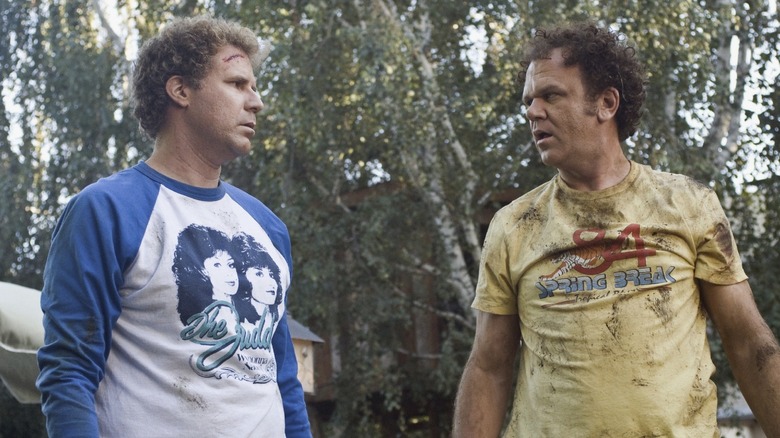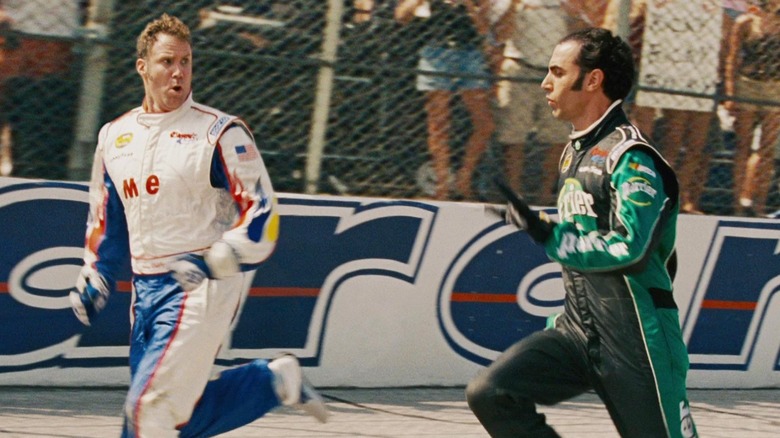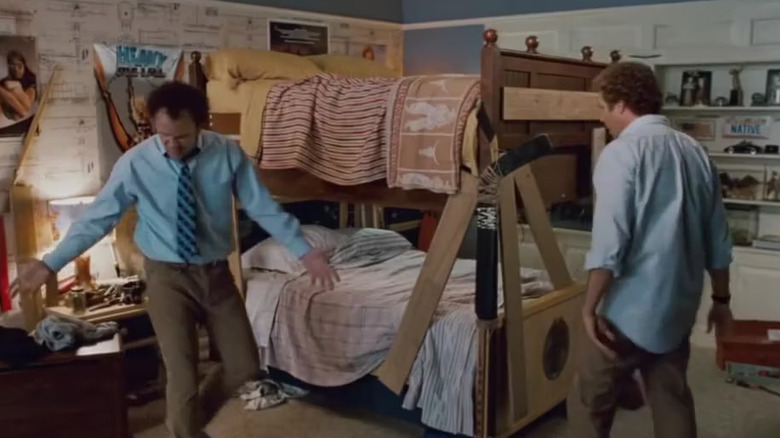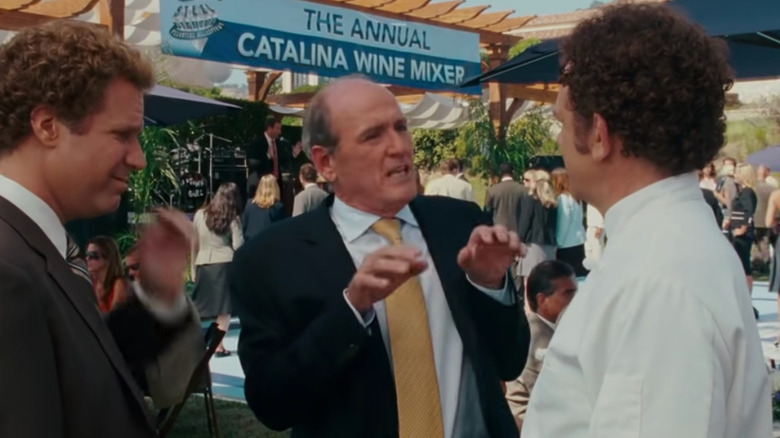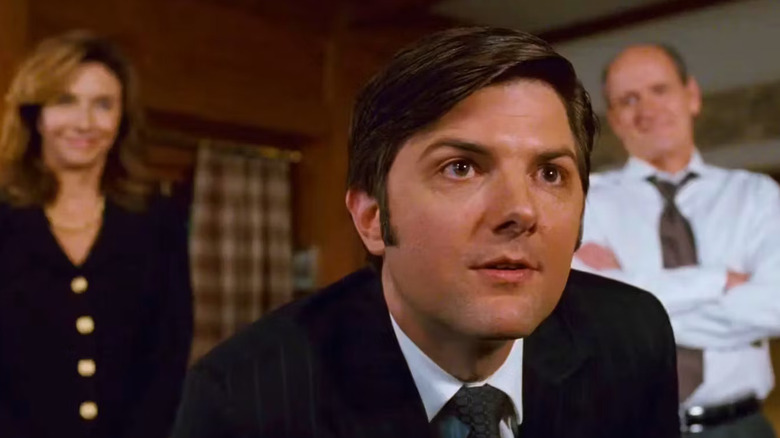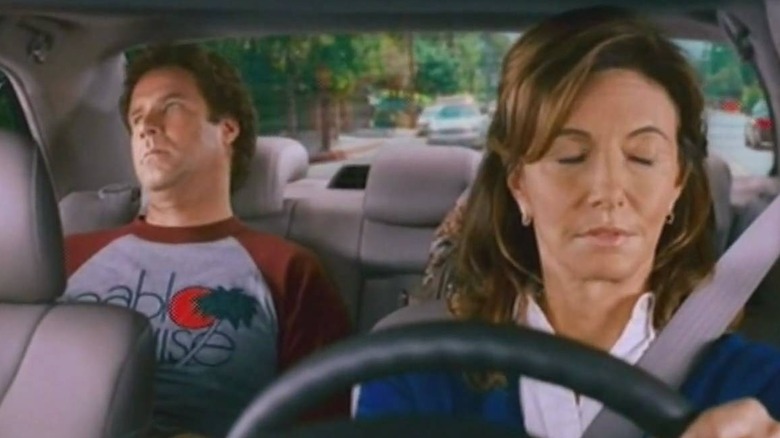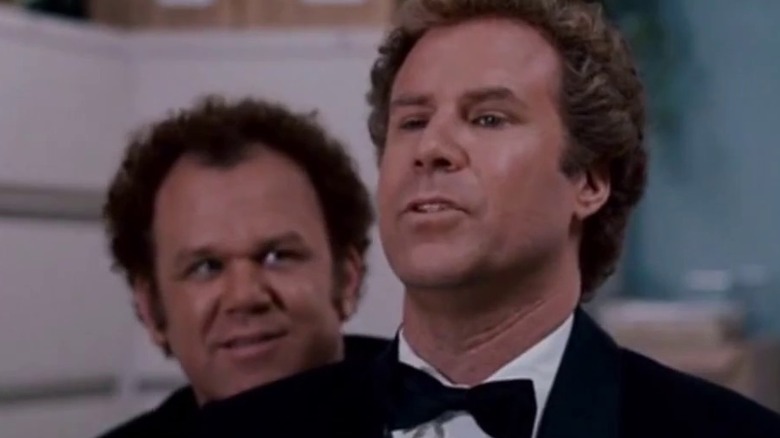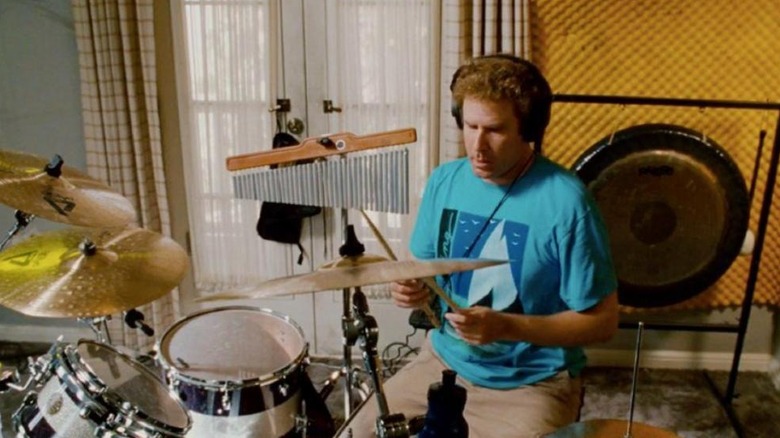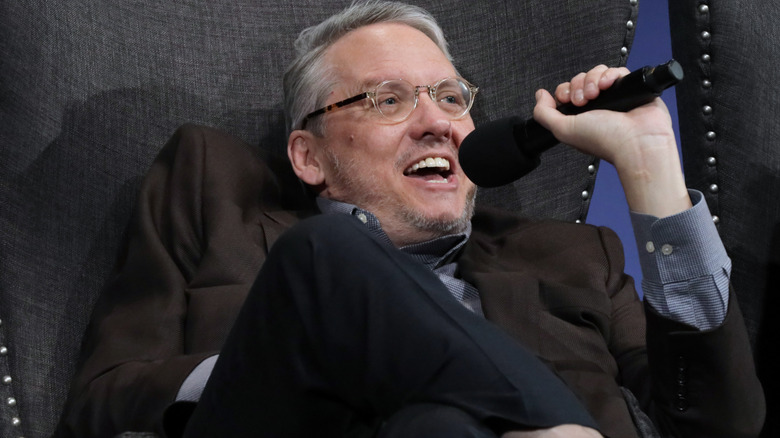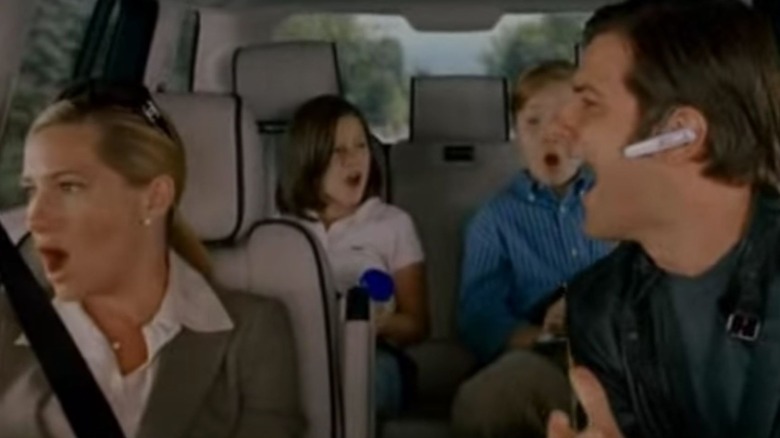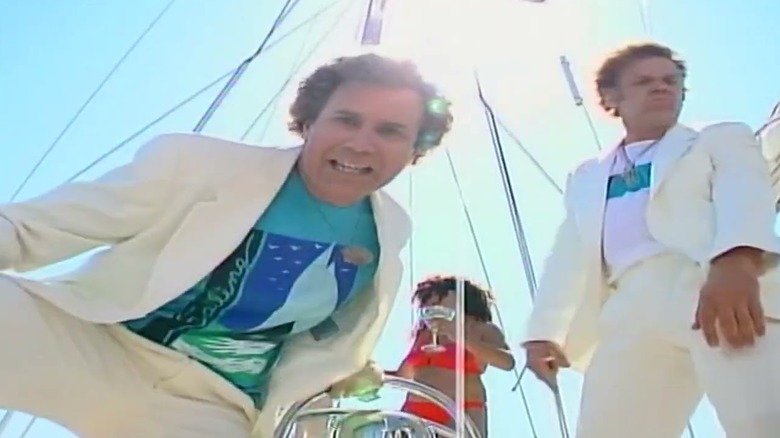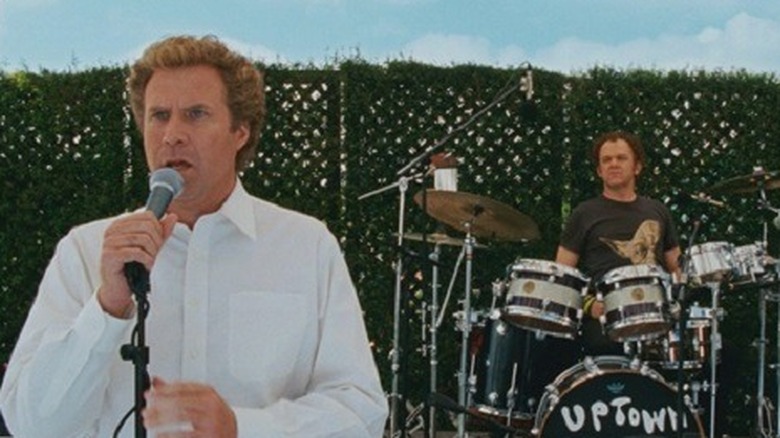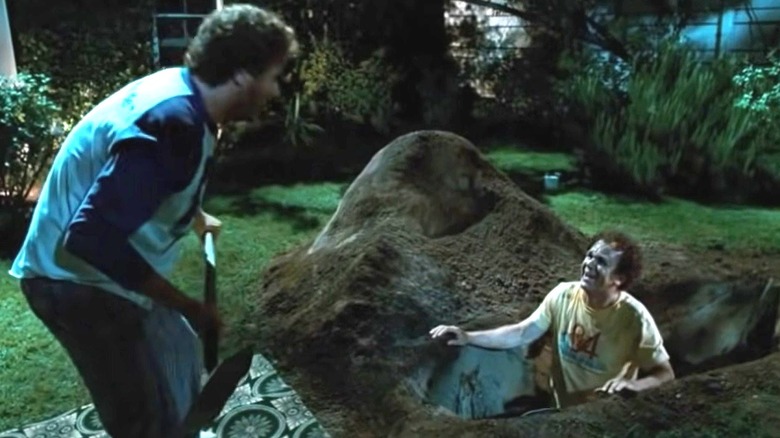The Untold Truth Of Step Brothers
It may not have had the box office success or the mostly positive critical reception of "Anchorman" or "Talladega Nights," but the third collaboration between filmmaker Adam McKay and actor Will Ferrell has certainly earned its distinction as a comedy cult classic. That movie, 2008's "Step Brothers," reteamed Ferrell with his "Talladega Nights" co-star John C. Reilly in a ridiculously funny tale of two immature and ambitionless men who still live with their respective single parents despite pushing middle age — and find themselves reluctant step-siblings after their parents get married.
Arriving at a time when theatrically-released comedies from big studios were becoming a dying breed as the genre began to move mostly to streaming, "Step Brothers" also feels like something of a last hurrah for films starring the group of actors known as the Frat Pack. In addition to featuring performers like Ferrell and Reilly at the top of their game, the movie also gives Mary Steenburgen and Richard Jenkins a chance to stretch their comedy muscles in a way they don't normally get to, as well as being an early showcase for future stars Adam Scott and Kathryn Hahn.
By all accounts, it was just as much fun to make "Step Brothers" as it was to watch it, and there is a lot about the movie that may surprise even those who re-watch it on a regular basis.
It was supposed to be a cooldown after Talladega Nights
"Talladega Nights: The Ballad of Ricky Bobby" had been a much more complex shoot than director Adam McKay was used to up to that point, with racing scenes, stadiums full of people, numerous different locations, and hot conditions on and around the track. He decided that he wanted his next movie to be the complete opposite of that, and be a much easier and more chill production — and have as much of it take place on a single set as possible.
The result was "Step Brothers," a large chunk of which takes place within a single house and rarely involves more than two to four characters in any given scene. McKay also wanted most of it to focus on Will Ferrell and John C. Reilly, whose scenes together in "Talladega Nights" were often the funniest parts of that movie as they demonstrated their effortless comedic chemistry with one another. Between those basic goals and some brainstorming with Ferrell and Reilly during the editing of "Talladega," the foundation of "Step Brothers" was laid out.
Many scenes were based on real experiences
Adam McKay, Will Ferrell, and John C. Reilly are all credited for the story of "Step Brothers." That's because, not only did they come up with the movie's basic premise, but they each shared stories from their own lives and experiences that ended up being reworked into some of the movie's most popular gags. For instance, Ferrell said that he lived with his parents for a few years after finishing college, and that his mom was extremely calm and patient about the whole thing, which obviously played heavily into developing the story and the four main characters.
There are more specific — and more outlandish — examples as well. Reilly recalled that he had a brother who was over-the-top about not letting anyone touch his drum set. That just made Reilly obsessed with wanting to sneak in and play it when his brother was around just to spite him. Ferrell also shared that his musician father, who wasn't especially handy, nonetheless still built a bunk bed for Ferrell that always felt shaky and precarious. And McKay said that he had heard a story about an adult in his neighborhood backing down after one of McKay's 12-year-old friends physically threatened them. Fans of the movie will already be more than familiar with which "Step Brothers" scenes those anecdotes inspired.
There was constant improvising, and not just from Ferrell and Reilly
Will Ferrell is famous for his improvisation skills, and his best movies are the ones where he's allowed to just riff and take multiple cracks at a specific line or reaction. It became apparent after doing "Talladega Nights" that John C. Reilly could more than keep up with Ferrell as an improviser; watching the two of them feed off each other and come up with bits on the spot is a thing of beauty. Clearly they do a lot of that in "Step Brothers" as well, and the movie is all the better for it.
But they weren't the only ones improvising. Adam McKay not only encouraged everyone to riff as they saw fit, but he'd often throw out lines or actions for actors to say or perform on the spot — sometimes without the other actors knowing. One of the best examples of this was when McKay pulled Richard Jenkins aside and instructed him to tell Ferrell and Reilly's characters that his childhood dream was to be a dinosaur, something the two had no idea he was going to say. Jenkins fully commits, with hand gestures and all, as his fictional son and stepson react with hilarious skepticism. Jenkins was certain that the ridiculous moment wouldn't actually be in the movie, but McKay assured him it would — and he was right.
It served as comedy training for Adam Scott
These days, Adam Scott's comedy bona fides have been well-established, thanks to being a series regular on both "Party Down" and "Parks and Recreation." But there was a time when he was actually mostly known for dramatic roles — in fact, his last big role before "Step Brothers" was in HBO's one-season drama "Tell Me You Love Me." Luckily, he had both Judd Apatow and Paul Rudd to vouch for him, with Rudd telling the "Step Brothers" crew (via The Ringer), "Adam Scott's one of the funniest guys I know." And with that, Scott was chosen to play the slimeball brother of Will Ferrell's character over the other main contender for the role: Jon Hamm.
Scott later said that his experience on "Step Brothers" — getting to learn from and be treated as an equal by so many talented comedic performers — was a turning point for his career and the kinds of roles he was able to do. He confirmed that he never would have had the confidence to go out for either "Parks and Recreation" or "Party Down" if it weren't for how positive the experience was and how much praise he got for doing "Step Brothers."
Mary Steenburgen cracks several times in the movie
"Step Brothers" certainly wasn't Mary Steenburgen's first comedy. It wasn't even her first Will Ferrell movie — she had previously played his stepmother in the Christmas classic "Elf." But it was with her role as Nancy Huff that she got to not only be around some of the craziest comedy of her career, but also got to let loose herself in a way that she rarely gets to do. While she spends much of the movie as the calmest and most rational of the four main characters, she does have a few moments where she loses her cool in an absolutely hilarious way.
It can't be easy trying to keep a straight face while actors like Ferrell and John C. Reilly are going for it, and Steenburgen admitted that she was terrible about keeping a straight face or not giggling during scenes. In fact, there are multiple examples of her clearly cracking that can be seen in the final cut of the movie, perhaps most notably during the uproarious sleepwalking scene. Steenburgen said that she asked director McKay why he kept her laughing in the movie, to which he responded that she laughed in every take so he didn't really have a choice.
Kodak thanked the production with a gift for using so much film
The blooper reel for "Step Brothers" is just a small taste of how many takes and how many versions they did of various scenes. Adam McKay has claimed that over a million feet of film was shot during the movie, which seems like an exaggeration — but perhaps he's telling the truth. Kodak, the company that provided the film, was certainly happy with how much stock the production purchased from the company — so much so that it sent champagne to the set as a thank you, before filming had even ended.
While having to whittle down dozens of hours of footage into a 98-minute movie might sound like a laborious chore, it's probably a much more pleasant job when all of that footage is hilarious. The toughest part is having to let go of so much comedy gold for the sake of a concisely-paced film. To that end, the first cut of "Step Brothers" was about five hours long — which meant that three and a half hours of what was probably gut-busting material had to be deleted in order to trim the movie down to a theatre-friendly length. If only people had petitioned as hard for the McKay Cut of "Step Brothers" as they did for the Snyder Cut of "Justice League."
The body part in that infamous gag was very expensive
It becomes clear pretty early on in "Step Brothers" that the movie isn't going to pull any punches, and there are no lines it won't cross for a laugh. Even with that in mind, when Brennan threatens to put his you-know-what on Dale's drums, few people watching expected to actually see it happen — and up close, no less. Sure enough, in one of the movie's most infamous moments, Brennan defiles Dale's drums in the most hilariously disgusting way possible.
No, those weren't actually Will Ferrell's bits. They were created by a top Hollywood prosthetics company, one that productions usually turn to for things like masks and other non-scatalogical effects pieces. It was important that they looked realistic and could hold up to scrutiny during their close-up. For what amounted to a single gag and only a few seconds of screen time, the prosthetic cost a hefty $10,000 to make. But they did get more use than just that one scene — lots of people on the set wanted to touch them to see how real they felt. And Will Ferrell being Will Ferrell, he insisted on keeping them after the shoot, and claims he shows them off at dinner parties.
The director's laughing became a problem
Adam McKay loves to laugh, and people who work with him say that he's got the kind of laugh that makes you feel like you're the funniest person on the planet. And he doesn't just laugh, but laughs out loud. While that's normally not an issue, it can be a problem when you're trying to film a movie and the director's belly laughing can be heard off-screen. Mary Steenburgen said that McKay's audible laughter was ruining so many takes that he had to move the video village much farther from the set than it normally would be positioned.
For those who don't know, a video village is the area where the director sits, surrounded by monitors and other equipment. A common misconception is that a director is always directly behind the camera, or is even operating the camera. While this is certainly true in some instances, typically a director hangs back a bit so that he or she can see how the scene is playing on screen rather than how it looks live. So it was easy enough to move McKay far enough away from where scenes were being shot so that he could chuckle as loudly as he needed to, without interfering with filming.
The singing in the car scene was all live
The titular step brothers aren't the only siblings who play a significant role in the movie. We eventually meet Brennan's biological brother, Derek (Adam Scott), who is essentially the opposite of Brennan in every possible way. When we first meet Derek, he's driving with his wife (Kathryn Hahn) and kids (Lurie Poston and Elizabeth Yozamp) as he leads them in an a capella performance of the Guns N' Roses classic "Sweet Child O' Mine."
According to Adam McKay, the movie's music supervisor insisted that the singing be live rather than looped, as that was the only way to ensure that the scene had the necessary energy. So what you're hearing in the movie is singing that is actually happening right there on camera. However, while Hahn and the children all did their own singing, Scott didn't quite have the necessary vocal chops to sell Derek as the power singer he needed to be. But Derek's singing is still being done live — it was just done by a professional singer, who was standing right outside the car (which was on a soundstage in front of a green screen). Scott needed to keep an eye on the singer to make sure his lip synching matched the singer's voice.
There was almost an entire Dale and Brennan rap album
When Brennan and Dale finally get their act together and try to launch their own business, they announce the venture — which they call Prestige Worldwide — with a business pitch in the form of a rap music video. We can't say the full name of the title here, but it involves boats and an offensive word for women. A fun little tidbit is that the song's chorus is actually being rapped by director Adam McKay, directly from the phone call between McKay and the song's producer where McKay described how he wanted the song to sound. The producer took it literally, and just used the audio from that phone call in the song itself.
Ferrell and Reilly as a rap duo almost extended beyond that song. There had been talks of doing an entire album of Ferrell and Reilly rapping in character as Brennan and Dale — something Reilly already had some experience with when he did several live performances in character as Dewey Cox from "Walk Hard." Unfortunately, everyone involved just got too busy with other projects and couldn't really devote the time to recording an album, and the project fell apart. Given that Ferrell and McKay's professional partnership — as well as their friendship, it seems — came to a bitter end in 2019, it's unlikely the album will ever be revisited.
Ferrell and Reilly sing the DVD commentary
Other than Adam Scott cheating during the car singing scene, everyone else who sings or plays music in "Step Brothers" is actually doing it. This includes Horatio Sanz as the singer in a cover band of a very specific era of Billy Joel, as well as Ferrell singing and Reilly playing drums during their Catalina Wine Mixer performance. Music played a big part in the movie, not only during the film itself but also in the supplemental materials of its home video release.
The DVD commentary for "Step Brothers" features McKay, Ferrell, Reilly, and the movie's composer, Jon Brion. But Brion isn't there to talk — he's there to play music while the other three do portions of the commentary via awkwardly ad-libbed songs. Given that the movie came out near the tail end of the era when people were still buying DVDs, and most fans have been content to watch the movie on streaming, not many people realize that this bizarre and hilarious commentary track even exists, let alone have actually heard it.
For what it's worth, there are ways to hear it online, but it's not quite the same without having the movie playing behind it. There aren't a lot of reasons to keep a DVD player accessible these days, but for diehard "Step Brothers" fans, this should definitely be one of them.
The original idea for the ending was extremely dark
"Step Brothers" gets pretty dark a few times — such as the scene where Brennan attempts to literally bury Dale alive. But there were a few scenes that were even darker than anything that actually made it into the final cut, including an ending that McKay and Ferrell were both big fans of, but was rejected by both Sony and producer Judd Apatow.
The ending, which Ferrell and McKay said they found absolutely hilarious, was to have Brennan and Dale proclaim that they are finally adults. The movie would have then cut to them wearing army fatigues and riding in a truck going down a bumpy desert road, past a sign reading "Fallujah, 3 Kilometers." But McKay said that he was told they couldn't shoot that scene, and admitted that it would have made the ending a huge downer. It makes you wonder what other dark places McKay and Ferrell have wanted to take their movies but weren't allowed to.
